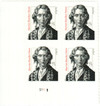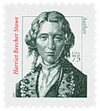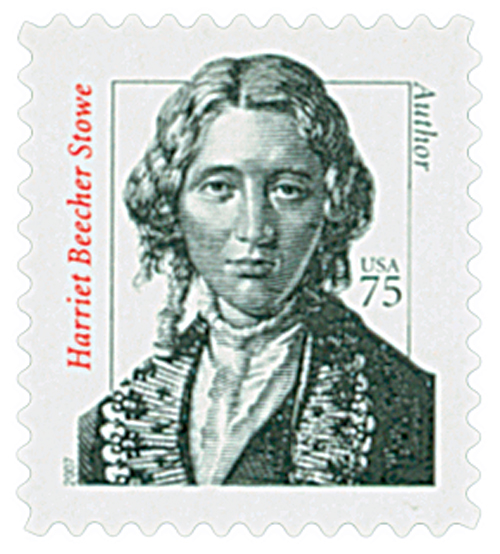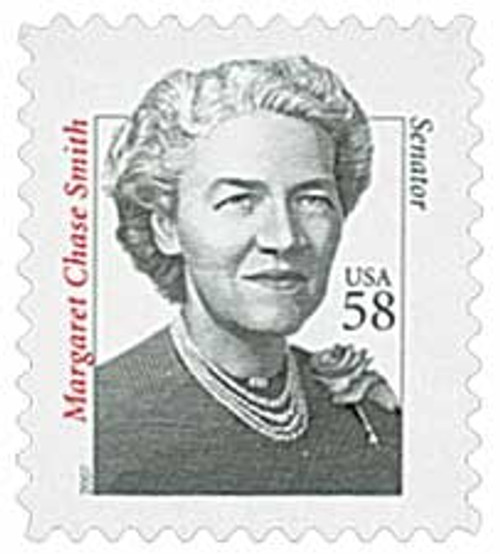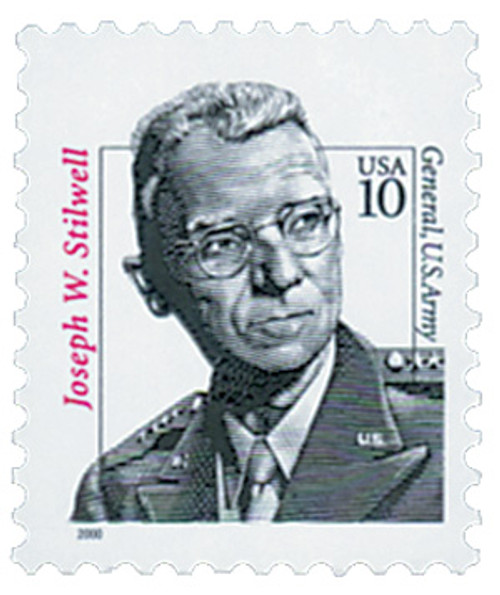
# 3430 - 2007 75c Distinguished Americans: Harriet Beecher Stowe
75¢ Harriet Beecher Stowe
Distinguished Americans Series
City: Washington, DC
Printed by: Banknote Corporation of America
Printing Method: Lithographed and engraved
Perforations: Serpentine Die Cut 11 ¼ x 10 ¾
Color: Red and black
Publication Of Uncle Tom’s Cabin
From the late 1700s to the mid-1800s, the issue of slavery was hotly debated in the American government. Northern and Southern politicians clashed over the addition of new states that did or did not allow slavery. To diffuse the tension, the Missouri Compromise was passed in 1820. This bill allowed Missouri into the Union as a slave state and Maine as a free state, maintaining an equal balance of representatives from pro- and anti-slavery regions in Congress.

Thirty years later, the debate continued over land acquired from the Mexican-American War. Kentucky Senator Henry Clay drafted a new compromise that failed to pass in early 1850. He then joined forces with Stephen Douglas of Illinois, who divided the bill into smaller pieces of legislation, which all passed. This Compromise of 1850 admitted California as a free state, made Texas surrender its claim to New Mexico in exchange to the Texas Panhandle and El Paso, strengthened the Fugitive Slave Act, and allowed for the possible admittance of New Mexico and Utah as slave states.
While the act prevented a civil war at the time, people on both sides were still unhappy with aspects of it. Among the dissatisfied was Connecticut-born teacher Harriet Beecher Stowe. Stowe was an active abolitionist and was outraged particularly by the Fugitive Slave Law, which allowed slave owners to take back any slaves that had escaped to other states or territories. When she lived in Cincinnati years earlier, Stowe and her husband were part of the Underground Railroad, providing shelter in their home to fugitive slaves on their journey to Canada.
Stowe was also inspired to write the story after the death of her 18-month-old son, claiming “Having experienced losing someone so close to me, I can sympathize with all the poor, powerless slaves at the unjust auctions.” She wrote to the editor of the abolitionist journal, The National Era, informing him she planned to write a story about the slavery issue. She had said, “I feel now that the time is come when even a woman or a child who can speak a word for freedom and humanity is bound to speak… I hope every woman who can write will not be silent.”
Some of Stowe’s inspiration came from the 1849 story, The Life of Josiah Henson, Formerly a Slave, Now an Inhabitant of Canada, as Narrated by Himself. Henson had escaped slavery in 1830 and made it to Canada, where he helped other fugitive slaves settle. She also utilized stories she’d heard from escaped slaves staying in her home in Cincinnati.
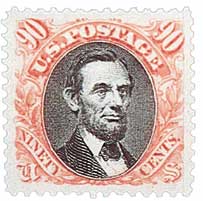
The first part of Stowe’s story appeared in The National Era on June 5, 1851. She first planned it run for just a few weeks but it was instantly popular, so she expanded it into a 40-week serial. It was so popular, readers lodged complaints when she missed an issue. Publisher John P. Jewett recognized the story’s appeal and approached Stowe about turning it into a book. Though she initially doubted anyone would want to read it as a book, she eventually agreed.
Uncle Tom’s Cabin; or, Life Among the Lowly, was published on March 20, 1852. It sold 3,000 copies on its first day alone and quickly sold out of the remainder of its print run. About 300,000 copies were sold that first year. Eventually, the book was translated into all major languages and was particularly popular in Great Britain.
Despite the book’s popularity with abolitionists, slave owners protested the book, calling it criminal and slanderous. One bookseller in Alabama was forced out of town for trying to sell the book in his store. In response to Stowe’s book, several southerners wrote their own novels refuting her stance and giving their pro-slavery view. Among them was Caroline Lee Hentz, a close friend that once lived with Stowe in Cincinnati. Many also criticized Stowe because she’d never been on a Southern plantation. To back up her claims, she published A Key to Uncle Tom’s Cabin in 1853, outlining the real life examples of each of her characters. This book was also a best seller.
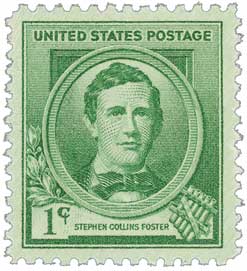
Not long after the book was published, several groups began putting on stage shows of Uncle Tom’s Cabin. While some were quite faithful to the book, others took great liberties. Its been estimated over 3 million people saw these plays, far more than read the book in its first year. There was even a musical version with songs by Stephen Foster, including “My Old Kentucky Home.” In the 1900s, the story was repeatedly produced as a silent movie. It was also made into a Disney cartoon in 1933.
Uncle Tom’s Cabin was the best-selling novel of the 19th century and the second best-selling book behind the Bible. Having been read or watched by most Americans in the late 1800s, the story popularized a number of African American stereotypes, for which is has been extensively criticized in the years since.
75¢ Harriet Beecher Stowe
Distinguished Americans Series
City: Washington, DC
Printed by: Banknote Corporation of America
Printing Method: Lithographed and engraved
Perforations: Serpentine Die Cut 11 ¼ x 10 ¾
Color: Red and black
Publication Of Uncle Tom’s Cabin
From the late 1700s to the mid-1800s, the issue of slavery was hotly debated in the American government. Northern and Southern politicians clashed over the addition of new states that did or did not allow slavery. To diffuse the tension, the Missouri Compromise was passed in 1820. This bill allowed Missouri into the Union as a slave state and Maine as a free state, maintaining an equal balance of representatives from pro- and anti-slavery regions in Congress.

Thirty years later, the debate continued over land acquired from the Mexican-American War. Kentucky Senator Henry Clay drafted a new compromise that failed to pass in early 1850. He then joined forces with Stephen Douglas of Illinois, who divided the bill into smaller pieces of legislation, which all passed. This Compromise of 1850 admitted California as a free state, made Texas surrender its claim to New Mexico in exchange to the Texas Panhandle and El Paso, strengthened the Fugitive Slave Act, and allowed for the possible admittance of New Mexico and Utah as slave states.
While the act prevented a civil war at the time, people on both sides were still unhappy with aspects of it. Among the dissatisfied was Connecticut-born teacher Harriet Beecher Stowe. Stowe was an active abolitionist and was outraged particularly by the Fugitive Slave Law, which allowed slave owners to take back any slaves that had escaped to other states or territories. When she lived in Cincinnati years earlier, Stowe and her husband were part of the Underground Railroad, providing shelter in their home to fugitive slaves on their journey to Canada.
Stowe was also inspired to write the story after the death of her 18-month-old son, claiming “Having experienced losing someone so close to me, I can sympathize with all the poor, powerless slaves at the unjust auctions.” She wrote to the editor of the abolitionist journal, The National Era, informing him she planned to write a story about the slavery issue. She had said, “I feel now that the time is come when even a woman or a child who can speak a word for freedom and humanity is bound to speak… I hope every woman who can write will not be silent.”
Some of Stowe’s inspiration came from the 1849 story, The Life of Josiah Henson, Formerly a Slave, Now an Inhabitant of Canada, as Narrated by Himself. Henson had escaped slavery in 1830 and made it to Canada, where he helped other fugitive slaves settle. She also utilized stories she’d heard from escaped slaves staying in her home in Cincinnati.

The first part of Stowe’s story appeared in The National Era on June 5, 1851. She first planned it run for just a few weeks but it was instantly popular, so she expanded it into a 40-week serial. It was so popular, readers lodged complaints when she missed an issue. Publisher John P. Jewett recognized the story’s appeal and approached Stowe about turning it into a book. Though she initially doubted anyone would want to read it as a book, she eventually agreed.
Uncle Tom’s Cabin; or, Life Among the Lowly, was published on March 20, 1852. It sold 3,000 copies on its first day alone and quickly sold out of the remainder of its print run. About 300,000 copies were sold that first year. Eventually, the book was translated into all major languages and was particularly popular in Great Britain.
Despite the book’s popularity with abolitionists, slave owners protested the book, calling it criminal and slanderous. One bookseller in Alabama was forced out of town for trying to sell the book in his store. In response to Stowe’s book, several southerners wrote their own novels refuting her stance and giving their pro-slavery view. Among them was Caroline Lee Hentz, a close friend that once lived with Stowe in Cincinnati. Many also criticized Stowe because she’d never been on a Southern plantation. To back up her claims, she published A Key to Uncle Tom’s Cabin in 1853, outlining the real life examples of each of her characters. This book was also a best seller.

Not long after the book was published, several groups began putting on stage shows of Uncle Tom’s Cabin. While some were quite faithful to the book, others took great liberties. Its been estimated over 3 million people saw these plays, far more than read the book in its first year. There was even a musical version with songs by Stephen Foster, including “My Old Kentucky Home.” In the 1900s, the story was repeatedly produced as a silent movie. It was also made into a Disney cartoon in 1933.
Uncle Tom’s Cabin was the best-selling novel of the 19th century and the second best-selling book behind the Bible. Having been read or watched by most Americans in the late 1800s, the story popularized a number of African American stereotypes, for which is has been extensively criticized in the years since.






